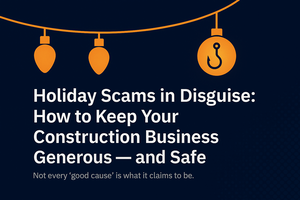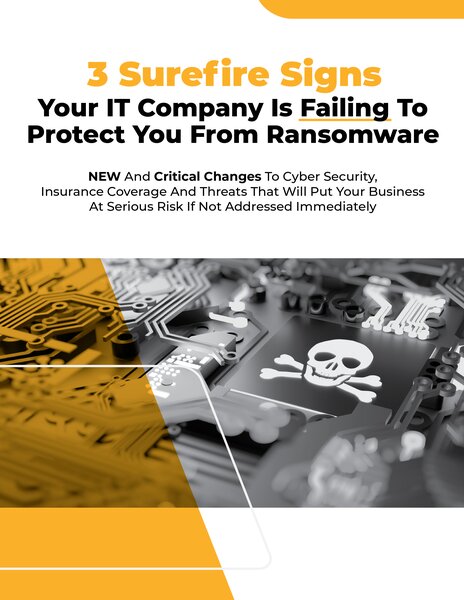 Every December, something funny happens in construction.
Every December, something funny happens in construction.
Crews slow down, the job sites quiet a bit, and the inbox fills up with two things:
- Last-minute invoices that absolutely must be paid before year-end, and
- Charity requests that sound just heart-tugging enough to get past your guard.
And scammers know it.
During the holidays, when emotions are high and time is short, cybercriminals treat generosity like an open season. One wrong click, one “donation link” that wasn’t what it claimed to be, and suddenly your business is tangled in fraud you never meant to touch.
A few years ago, the FTC shut down a massive telefunding scam that made 1.3 billion deceptive calls and raked in over $110 million from people who simply wanted to help.
On social media, researchers found 800+ fake fundraising accounts pushing bogus campaigns across Facebook, Instagram, and X.
And here’s the part most construction firms never think about:
A bad donation doesn’t just cost you money.
It can pull your company’s name into the mess — and that can damage trust with clients, partners, and your community.
Let’s make sure that doesn’t happen to you.
How to Vet a Fundraiser Before You Donate
If you’re donating on behalf of the company, or your employees are using the business name, you want answers to four simple questions:
- Who organized the fundraiser, and what’s their real connection to the recipient?
- Where exactly is the money going, and when?
- Who controls the withdrawals — and is there a clear process for getting funds to the right person?
- Do people close to the recipient (family, coworkers, community) publicly support the campaign?
If any of that is fuzzy, vague, or answered like a high-schooler stalling during a book report?
Hit pause. Something’s off.
Red Flags That Should Make You Walk Away
If you see any of these, don’t donate:
- Info that doesn’t match across the fundraiser, social media, or news
- Stories that feel too perfect, dramatic, or emotionally manipulative
- Fundraisers that were copied from someone else’s real tragedy
- Donations sitting unused for long stretches with no updates
One red flag is enough.
Two is too many.
Three? Report it and run.
Not All “Charities” Are Actually Charities
Crowdfunding isn’t the only place scams live. Some “charities” look polished but operate like a revolving door of questionable bookkeeping.
Before giving:
- Look for detailed program descriptions and annual reports
- Check how much of each dollar actually goes to impact versus overhead
- Search the charity name with words like fraud, scam, complaints
- Read the reviews — real ones, not the cherry-picked testimonials
If transparency is missing, the trust should be too.
The Sneaky Tactics Scammers Use in December
These sound familiar for a reason — they’re the same tricks used in business email compromise:
- “Donate via gift cards, wire transfers, or crypto only.”
(Translation: you can’t get it back.) - Websites without https — meaning anyone can intercept your info
- High-pressure messages that push you to “act now before midnight!”
- Claims you’ve donated before, even though you haven’t
If someone’s rushing you, it’s not charity — it’s a setup.
Why This Matters for Construction Firms
This is where your CFO’s ears perk up.
Charitable giving isn’t just generosity — it’s a public act. When your business supports a cause, people associate your reputation with it.
Get burned by a scam, and suddenly:
- Clients question your judgment
- Partners worry about your internal controls
- Your brand looks sloppy or careless
And here’s the kicker:
The same tactics that power charity scams also power invoice fraud, phishing attempts, and payment redirection attacks — the stuff that keeps your IT team awake at night.
Teaching your staff to spot fake fundraisers also teaches them to spot the scams that hit your AP inbox, your project managers, and your jobsite devices.
It’s all connected.
How to Protect Your Business (and Your Goodwill)
Here’s what smart construction firms in Houston are doing:
- Create a simple donation policy.
A quick one-pager that outlines when and how the company gives — and who approves what.
- Train your employees.
Show them what fake fundraisers look like and how scammers overlap tactics across emails, texts, and social media.
- Use trusted channels only.
Go directly to official websites — never click links in random messages.
- Vet charities the way you vet subcontractors.
Check history, transparency, and reputation.
- Follow up after donating.
Reputable charities publish impact reports or updates. Make sure the money goes where it should.
Keep the Holidays Generous — Not Risky
This season should be about giving back — not giving away access, money, or your good name.
If you want to make sure your team knows how to spot scams across all fronts — the fake fundraisers, the holiday phishing emails, the bogus vendor updates — let’s talk.
A quick, friendly walkthrough can save your company thousands… and a whole lot of embarrassment.
Book your free 15-minute discovery call
Because the best gift you can give your business (and your community) is trust that no scammer can steal.



